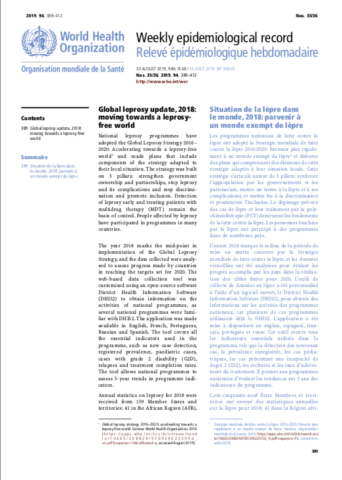
WHO Global Leprosy Update
The 2018 Global Leprosy Update was published in the Weekly Epidemiological Review on 30 August. This report is WHO’s snapshot of the global leprosy situation at the end of 2018. This year’s report is longer and more thorough than the previous one, with a wealth of detailed country information. Read the full report here or read Dr Paul Saunderson’s, chair of the ILEP Technical Commission, brief commentary below.
Commentary on the Global Leprosy Update, 2018, published by WHO on 30 August 2019
By Dr Paul Saunderson
There are two very welcome and important changes in the current Global Leprosy update from WHO. Firstly, it includes for the first time an analysis of the new leprosy case detection rate in children (or, to be more precise, the age-specific rate in children), which provides a clearer picture of the trend towards reduced transmission than any other indicator that is easily available. Secondly, the report is much longer than previous reports. At 23 pages of the Weekly Epidemiological Record, and includes much additional information, analysis and commentary. It also includes country level data which had to be presented in a supplementary Table last year.
In the past, it has been routine to talk about the percentage of all new cases that were under 15 years of age; usually this was under 10%, sometimes as low as 3%, but in some of the highly endemic islands, as high as 30%. This was a reasonable indicator when the number of cases was high, but as the total number of cases (the denominator in the equation) gets lower, the result is less meaningful. For example, if there are only 10 cases reported, one child is already 10% of the total. A larger and more stable denominator is needed, and the total number of children in the population being considered seems the most appropriate: the number of leprosy cases in children can then be expressed per 100,000 children (or per million children), giving a much more stable figure which will show trends over time and allow comparisons between different areas. Another advantage of this indicator is that we already have the data for at least the last 30 years on which to base the calculations.
Figure 1 of this year’s report (on page 397 of WER, 2019: 94, 389-412) shows trends in the new leprosy case detection rate among children, by WHO Region, 2014-18. There is a general downward trend, with differences between regions. Although population size is growing, the downward trend can be confirmed by looking at the actual number of new cases reported in children (for example, 22,450 in 2007; 18,719 in 2014; and 16,013 reported in 2018). Global indicators may be distorted by the inclusion of large populations with very few cases (cf. global prevalence figures around the year 2000), and this effect is seen to a lesser extent in the regional figures used in Figure 1. At the other extreme, looking at very small areas with low populations is also distorting. In general, the new case rate in children is ideal for looking at trends in country-level data, and it is very good to see that the “data are being analysed for all countries for further discussion of use of this indicator in understanding recent transmission of infection.” (Pages 397-8)
With new recommendations from WHO last year on the prevention of leprosy, it is important to find ways to monitor any effects these may have, and the rate of new cases in children may be very useful in this respect. The new case rate in adults is likely to decline slowly in parallel, but the graph of that decline will have a long tail, as the cases with a long incubation time appear over several decades in the middle-aged and elderly populations (cf. leprosy elimination in Norway, between 1860 and 1920: Irgens LM. Int J Lepr 1985: 53, 610-617).
Progress towards targets relating to disability and discrimination remains steady, but trends will only be apparent over several years. Relatively new columns in the database include the number of child cases with Grade 2 disability, the number of foreign-born cases, and the numbers of relapses and retreatment cases. All of these indicators show an increase from the 2017 data, but this is most likely due to more complete reporting: trends will only become clear when more datapoints are published.
In its Editorial note (pages 399-400), WHO mentions a possible new indicator that could be reported, namely the coverage of contacts with chemoprophylaxis. On the principle of ‘what gets measured, gets done,’ ILEP should encourage WHO to ask countries to report this information, for inclusion in future reports. If space is a problem, now may be a good time to ditch the prevalence figures once and for all. While the first few years may not give accurate or complete information, this would gradually improve. Promoting chemoprophylaxis in contacts helps to promote contact examination, which is the most cost-effective method of improving new case detection, with the subsequent benefit of reduced Grade 2 disability in new cases. Ideally, countries could report the number of contacts (or people in any other defined target group) examined, and the number given chemoprophylaxis; the first number should always be higher than the second, and will allow countries to report active case-finding activities, even if the uptake of chemoprophylaxis proceeds more slowly.